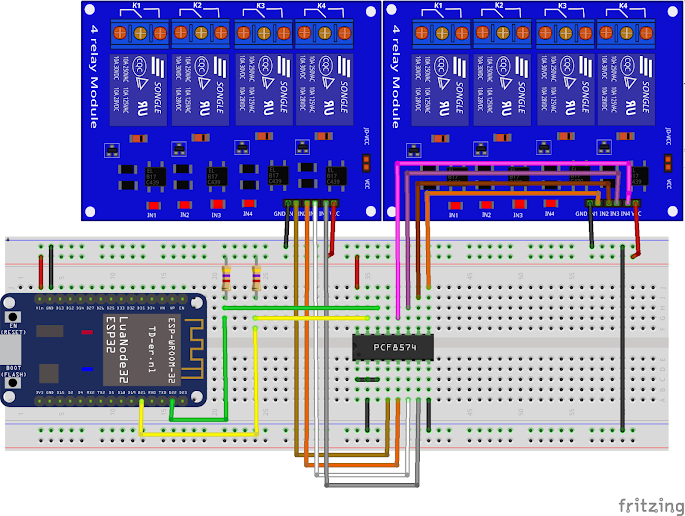bonjour les SMHOSYIENS
PRÉSENTATION :
Une petite base de domotique en bluetooth LE sur un ESP32 commander par une application android
voici comment réaliser simplement une petite domotique d'appartement a moindres frais
MATÉRIEL NÉCESSAIRE :
- 1 ESP32
- 1 PCF8574AN
- 2 resistance de 4.7 kΩ
- 1 Module de 8 relais avec optocoupleur
- un accès a Thunkable
- 1 smartphone ANDROID
ayant envie de comprendre un peu le bluetooth LE je me suis dis quoi de mieux que de réalisé une petite domotique😁
j'ai donc ouvert l'exemple fournie dans arduino BLE_uart.ino puis fait plusieurs essai via Thunkable
ce qui nous donne une petite application entièrement configurable
Coté ESP32 il fallait pouvoir commander des relais j'ai opté pour l'i2c avec le PCF8574AN et un module de 8 relais
MONTAGE DE L'ESP32 :
Le montage est alimenté en 5 volts sur vin
LE CODE ARDUINO :
Je suis partie sur l'exemple fournie avec l'esp32 uart_ble
TUTO_BLE_ESP32.ino
/*
Based on Neil Kolban example for IDF: https://github.com/nkolban/esp32-
Ported to Arduino ESP32 by Evandro Copercini
adaptation par SMHOSY DAVID https://smhosy.blogspot.com/
petit tuto permettant le pilotage de 8 relais via une aplication android
Librairie PCF8574 https://github.com/skywodd/pcf8574_arduino_library
*/
#include <BLEDevice.h>
#include <BLEServer.h>
#include <BLEUtils.h>
#include <BLE2902.h>
#include "Arduino.h"
#include "PCF8574.h"
#include "config.h"
BLEServer *pServer = NULL;
BLECharacteristic * pTxCharacteristic;
bool deviceConnected = false;
bool oldDeviceConnected = false;
uint8_t txValue = 0;
// See the following for generating UUIDs:
// https://www.uuidgenerator.net/
#define SERVICE_UUID "6E400001-B5A3-F393-E0A9-E50E24DCCA9E"
#define CHARACTERISTIC_UUID_RX "6E400002-B5A3-F393-E0A9-E50E24DCCA9E"
#define CHARACTERISTIC_UUID_TX "6E400003-B5A3-F393-E0A9-E50E24DCCA9E"
//initialisation de l'I2C dans notre exemple @0x38
PCF8574 I2COutput(0x38);
// variable pour l'I2C
const int out_array[8] = {0,1,2,3,4,5,6,7};
int etat_out_array[8] = {1,1,1,1,1,1,1,1};
//fonction explode les donnée recu pour extraire l'API_KEY et la commande
String explode(String data, char separator, int index){
int found = 0;
int strIndex[] = { 0, -1 };
int maxIndex = data.length() - 1;
for (int i = 0; i <= maxIndex && found <= index; i++) {
if (data.charAt(i) == separator || i == maxIndex) {
found++;
strIndex[0] = strIndex[1] + 1;
strIndex[1] = (i == maxIndex) ? i+1 : i;
}
}
return found > index ? data.substring(strIndex[0], strIndex[1]) : "";
}
class MyServerCallbacks: public BLEServerCallbacks {
void onConnect(BLEServer* pServer) {
deviceConnected = true;
};
void onDisconnect(BLEServer* pServer) {
deviceConnected = false;
}
};
class MyCallbacks: public BLECharacteristicCallbacks {
String api_key_uart = "";
int btn = -1;
void onWrite(BLECharacteristic *pCharacteristic) {
std::string rxValue = pCharacteristic->getValue();
String recv ="";
if (rxValue.length() > 0) {
for (int i = 0; i < rxValue.length(); i++){
recv += rxValue[i];
}
}
// on eclate la varible de reception
api_key_uart = explode(recv, ':', 0);
btn = (explode(recv, ':', 1)).toInt();
// si l'API_KEY correspond
if(API_KEY == api_key_uart){
// on inverse l'etat de la pin
etat_out_array[btn-1] = 1 - etat_out_array[btn-1];
// on envoi la commande
I2COutput.digitalWrite(btn-1, etat_out_array[btn-1]);
Serial.print("[SUCCES] -> COMMANDE BTN : ");Serial.println(btn);
}
else
{
Serial.println("[ERROR] -> API_KEY NO CORRECT");
}
}
};
void setup() {
Serial.begin(115200);
/*Déclaration des I/O I2C */
for (int i=0; i<8; i++) {
I2COutput.pinMode (out_array[i], OUTPUT);
I2COutput.digitalWrite(out_array[i], etat_out_array[out_array[i]]);
}
I2COutput.begin();
// Create the BLE Device
BLEDevice::init("ESP32_BLE_smhosy");
// Create the BLE Server
pServer = BLEDevice::createServer();
pServer->setCallbacks(new MyServerCallbacks());
// Create the BLE Service
BLEService *pService = pServer->createService(SERVICE_UUID);
// Create a BLE Characteristic
pTxCharacteristic = pService->createCharacteristic(
CHARACTERISTIC_UUID_TX,
BLECharacteristic::PROPERTY_NOTIFY
);
pTxCharacteristic->addDescriptor(new BLE2902());
BLECharacteristic * pRxCharacteristic = pService->createCharacteristic(
CHARACTERISTIC_UUID_RX,
BLECharacteristic::PROPERTY_WRITE
);
pRxCharacteristic->setCallbacks(new MyCallbacks());
// Start the service
pService->start();
// Start advertising
pServer->getAdvertising()->start();
Serial.println("Waiting a client connection to notify...");
}
void loop() {
if (deviceConnected) {
pTxCharacteristic->setValue(&txValue, 1);
pTxCharacteristic->notify();
txValue++;
delay(10);
}
// disconnecting
if (!deviceConnected && oldDeviceConnected) {
delay(500); // give the bluetooth stack the chance to get things ready
pServer->startAdvertising(); // restart advertising
Serial.println("start advertising");
oldDeviceConnected = deviceConnected;
}
// connecting
if (deviceConnected && !oldDeviceConnected) {
// do stuff here on connecting
oldDeviceConnected = deviceConnected;
}
}
et le fichier config.h ou se trouve l'API_KEY
// varible api_key qui doit ètre identique a celle de l'application
android par defaut 123456789
String API_KEY = "123456789";
retrouver les code sur mon git : https://github.com/davi-domo/SMHOSY_BLE
voici le type de carte dans l'IDE ARDUINO
APPLICATION ANDROID :
Voici la fenêtre principaleet la fenêtre de configuration ou tout est modifiable
n'hésitez pas a commenter c'est gratuit




Commentaires
Enregistrer un commentaire